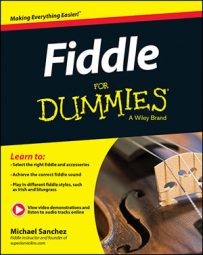There are a few fundamentals you should start with to build a good foundation for fiddle playing. “Garbage in, garbage out.” This phrase applies to many things in life. What you hear, what you see, and everything you learn affect what you do. Starting off with bad fiddle habits affects how you play going forward. Everyone knows that bad habits are hard to break!
Holding your fiddle properly
It may seem like holding your fiddle should be simple. Slap it under your chin, grab your bow, and you’re good to go! Wrong. Holding your fiddle improperly can lead to bad habits that are hard to fix later. You need to be able to hold it comfortably with no hands, which may be uncomfortable at first. Many people find that using a shoulder rest is best.
To hold the fiddle properly, bring the fiddle up to your left shoulder. Aim the button at the bottom of the fiddle toward the center of your neck. Point the scroll toward the left side of the music stand. Your fiddle should be pointing to your left about 45 degrees and parallel to the floor.
Keep your back and head straight, turn your head slightly to the left, and lower your left jaw and chin over the chin rest, pressing down with your chin so that you pinch your fiddle between the chin rest and your collarbone. This should allow you to hold your fiddle with no hands. Don’t let go unless you know for sure you aren’t going to drop it!
Bow stroke mechanics
The most important thing that can either make or break your fiddle progress is how you decide to hold the bow. To start, follow these points:
Your thumb should be curved and placed gently in the groove of the bow.
The rest of your fingers should make an angle on the bow.
Your pinkie should be curved at the button of the bow.
To get an idea of how you want to place your hand on the bow, drop your hand to your side and relieve any sort of tension in your hand. Look at your hand and see how naturally each finger is curved and how none of your fingers seem to naturally straighten out. That natural curve of each finger is the position you want.
Do you lift weights? If so, you’ll have a hard time at first with the lightness you need in your hand when holding the bow. Think about how you’d hold a baby bird that’s very tender and fragile. The same concept applies to how you should barely hold on to the bow. The fiddle essentially holds the bow for you; it’s just a matter of how you apply your index finger to guide it.
The key to practicing fundamentals is to work on them one at a time. Some of the most successful new fiddlers are those that take the drills and fundamentals seriously. The more you do something physically, the quicker your brain can tell your muscles to carry it out. If you practice your bow stroke incorrectly over and over, you’ll always do it incorrectly.
Knuckles up and angles back
Placing your left hand properly on the fiddle starts with understanding how to hold the instrument. You definitely want to make sure you understand that your chin and shoulder should hold the fiddle and not your left hand. Keeping your wrist straight is also very important to left-hand placement.
Understanding how to place your fingers down on the fingerboard is the next important point to consider. Mastering these fundamentals can lead to great fiddle playing; failing to execute them can lead to struggles finding the correct notes. Remember these fundamentals as keeping your knuckles up high and keeping your angles back.
Keeping your knuckles up means you need to have your hand high enough to be able to find every note on the fiddle without having to reach with your hand. Your hand should stay still as your fingers move.
When you start to put fingers down on the D and A strings, you may find it easy to reach notes with your fingers. Don’t lower your knuckles because of this, though; eventually, you’ll have to play notes way over on the G string and then jump to the E string.
You also have to be sure to keep your fingers angled back. Point all your fingers at your left shoulder. Place your middle finger down (pointing at your left shoulder) and see how far your ring finger can stretch. This is the proper way to angle your fingers.

